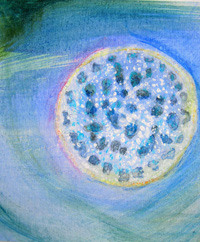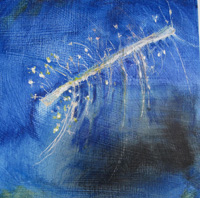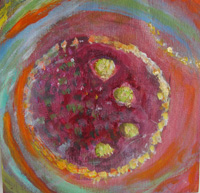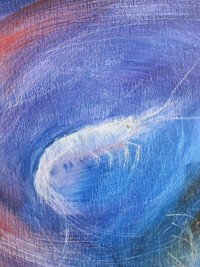Shedding Light: Art Explores
Science
An Exhibition at the Phipps Center for the
Arts, May 7 - June 6, 2010
| Installation by Susan
Armington:
In The Life Story of Petroleum I look at the origins of
petroleum from teeny plankton in the ancient seas up to the
present; where we pop it in our cars and drive off.
My art was inspired by life cycle analysis used by
physicists trying to figure out the costs to the environment of any
product, from its origin till it is used up – so from “cradle to
grave.” I got interested in this approach when I did a 5-day studio
collaboration with Professor
Valerie
Thomas from Georgia Tech, exploring how we could make 3-D
objects to give visual shape to concepts in energy use and analysis. We
worked on filling a suitcase with objects that represent a life cycle
inventory for sugar. |
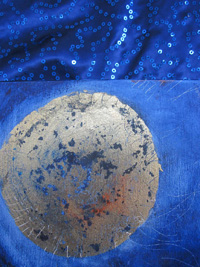 |
But I was personally stunned when I realized that
petroleum, which is the foundation for so much of our every day stuff –
plastics, gasoline, glue, paints, - comes from the residue of plankton from
prehistory that was cooked and processed in the earth for 400 million years. I
could hardly fathom it –the scale of time that passed and the tininess of the
plankton creating this stuff that we use routinely and throw away. It reminded
me of Pascal’s describing man as midway between nothingness and infinity (Un
néant à l'égard de l'infini, un tout à l'égard du néant, un milieu entre rien et
tout...). Here we are, ourselves just a dot in the timeline of the earth, and
we are busily using up the residue of life forms from millions and millions of
years ago. Through the timeline I attempt to show this connection of humans to
the ancient past, and the lifetime of the earth as well as to these miniscule
creatures whose lives lasted less than a day 400,000,000 years ago.
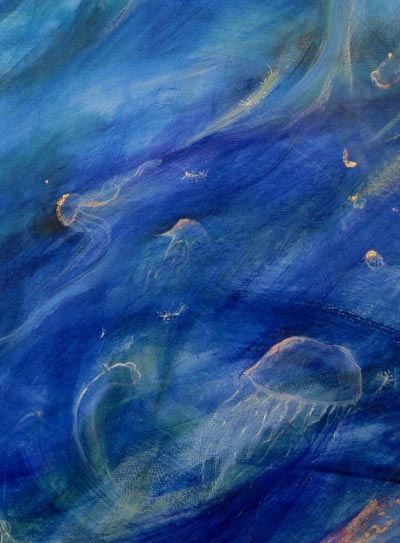 |
What does your art
offer the viewer in terms of a way of seeing or experiencing that might
be different from our ordinary approaches to science?
My artist’s view of the Life Story of Plankton is told with a
couple of narrative voices. Instead of an authoritative scientist who
offers fact after fact, the story is told as a fairy tale, beginning,
Once upon a time 400 million years ago. Along the way, the painter
and dramatist illuminate the gallery with images of plankton - first
lively and full of vitality and light; next, shimmering in the ocean
currents, and finally falling one by one into the dirt where they lay
and decay over millions of years. In this way the viewer is invited to
enter into an evocative story space of imagination and feeling. At the
same time, a scientistic voice accompanies the drama, framing events
with facts and footnotes and labeling and boxing them in as species and
types. The timeline belongs very much to the scientific realm, but the
expansion of it into the halls so that the viewers can experience it
with their bodies and through time and space is meant to carry the
viewer into the terrain of visceral and felt experience. The use of
tape to create the final images moves the viewer up into the present
world of oil; offering a contemporary view of where we are now. |
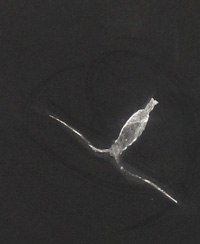
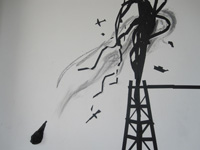 |
| Did you have any
discoveries while making your work? I fell under the
spell of plankton doing this work. There is such an array of these
creatures, and even now, tiny as they are ( a million can fit in a
teaspoon) they are responsible for creating more than 50% of the oxygen
we breathe. There are so many types and kinds – the word “plankton”
just means “wanderer, drifter” – a veritable deluge of animals, plants,
and creatures in between. I started to see them as a metaphor for
people….as we wander and drift through our lives, until we too fall to
the dirt, and decay. |
You can read and hear
MPR's Art Hound segment on this show

